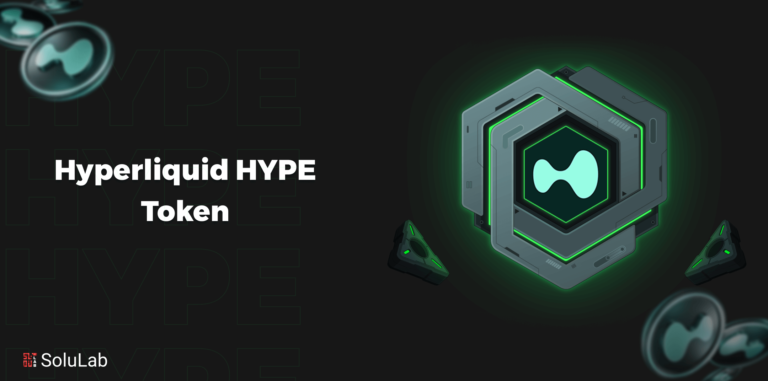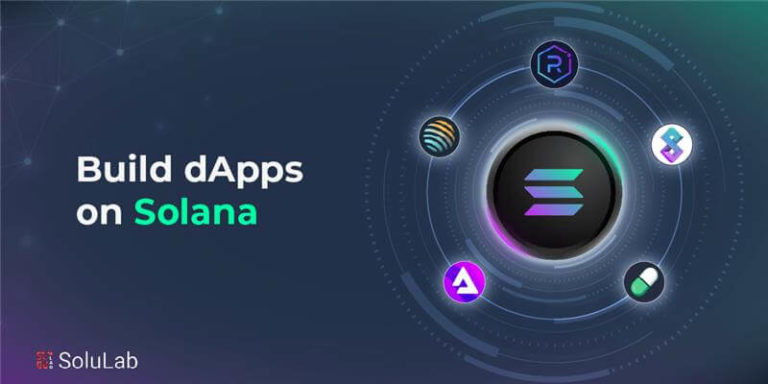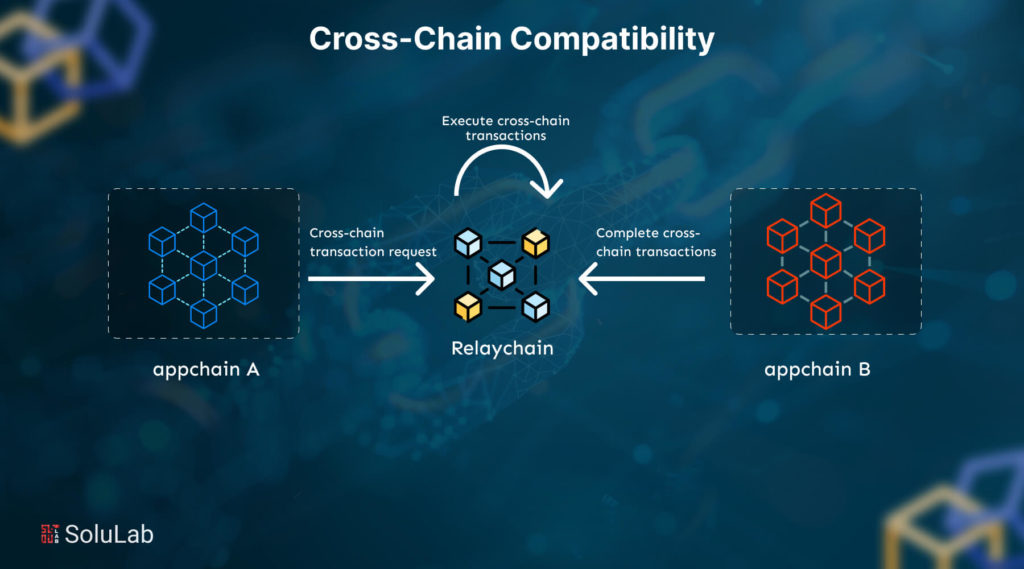
In the upcoming years, there may be thousands more public and private blockchains with trillions of dollars in value moving onchain, adding to the hundreds of public blockchains, layer1 vs. layer2 networks, appchains, and other types of networks that make up the multi-chain blockchain ecosystem. As per the latest news, LayerZero announced the activation of its cross-chain interoperability protocol on the Unichain testnet, enabling connections with over 90 blockchains. This integration aims to improve decentralized finance by enhancing scalability, accessibility, and cross-chain solutions
In 2024, blockchain technology is becoming more interconnected, with cross-chain integration driving the development of decentralized finance (DeFi), NFTs, and other blockchain-based applications. According to recent reports, the trading volume across protocols utilizing blockchain bridges reached over $661 million in early 2024, showcasing the rising demand for cross-chain solutions
It has never been more crucial to have smooth cross-chain exchanges and interactions between blockchains, especially in light of the rapidly growing number of distinct on-chain ecosystems. Cross-chain compatibility is now a fundamental component of the blockchain ecosystem as a result.
Cross-chain compatibility refers to the capacity of several blockchains to comprehend the information and resources of one another. We will look into what is cross-chain compatibility along with its working and applications.
Understanding Cross-Chain Compatibility in Blockchain
Cross-chain compatibility is becoming a vital concept within blockchain technology, as it enables seamless communication and interaction between different blockchain networks. Essentially, it refers to blockchain cross-chain technology that allows for the exchange of assets and data between diverse blockchains, without relying on third-party intermediaries.
In a cross-chain network, the goal is to create an interconnected ecosystem where digital assets, tokens, and even smart contract information can be transferred across various blockchain protocols. This opens the door to a more integrated and accessible blockchain world.
The importance of cross-chain integration can be compared to the way smartphones function across different platforms. Just like an iPhone user can communicate with an Android user, blockchain systems with cross-chain compatibility allow users on different networks, such as Ethereum, Polkadot, or Binance Smart Chain, to exchange assets or data efficiently.
With cross-chain compatibility, the boundaries between blockchain ecosystems dissolve, facilitating innovation and expanding the possibilities for decentralized finance (DeFi), NFTs, and other blockchain-based applications.
Benefits of Cross-Chain Compatibility
Cross-chain compatibility offers several key advantages that are transforming the blockchain ecosystem. As top blockchain development companies and platforms continue to explore new innovations, the demand for seamless blockchain interoperability has grown significantly. Here are some of the major benefits of cross-chain compatibility:
1. Enhanced Liquidity: By enabling the transfer of assets between different blockchains, cross-chain compatibility increases the overall liquidity of digital assets. This fosters greater accessibility for traders, investors, and users across various blockchain ecosystems, allowing them to engage in DeFi development across multiple platforms without restrictions.
2. Reduced Fragmentation: The blockchain space is often siloed, with each network functioning independently. Cross-chain solutions reduce fragmentation by creating a unified network where blockchains can interact and exchange value. This encourages collaboration between blockchains, enriching the ecosystem with new use cases and solutions.
3. Greater Innovation and Flexibility: As Blockchain-as-a-Service (BaaS) providers integrate cross-chain capabilities, developers gain access to a wider range of tools and features. This flexibility promotes innovation, as developers can use the strengths of various blockchain protocols to build more versatile decentralized applications (dApps).
4. Cost Efficiency: Cross-chain solutions can lower transaction fees by allowing users to switch between networks to take advantage of lower costs, increasing the efficiency of the overall system. This creates opportunities for a blockchain consulting company to deliver cost-effective solutions for their clients.
5. Interoperable Ecosystems: Cross-chain compatibility fosters the creation of interoperable ecosystems where different blockchain platforms, such as Ethereum, Binance Smart Chain, and Polkadot, can work together. This interconnectedness expands the possibilities for decentralized applications and services, driving the growth of blockchain technology.
By enabling multiple blockchains to interact, cross-chain compatibility ultimately brings more opportunities for growth, innovation, and the wider adoption of blockchain technology in industries across the globe.
Importance of Cross-Chain Compatibility
Cross-chain compatibility is fundamental for the future of blockchain technology, as it facilitates seamless communication and interaction between various blockchain networks. This interoperability is crucial in ensuring that blockchain ecosystems do not remain siloed but instead operate within an interconnected framework. Here are key reasons why cross-chain interoperability is so important:
- Enabling Asset Transfers Across Blockchains: With cross-chain bridges, users can transfer assets like tokens or NFTs between different blockchain platforms. For instance, moving a token from the Ethereum network to the Binance Smart Chain or using Bitcoin on decentralized applications (dApps) that exist on other blockchains becomes possible through these bridges. This promotes greater flexibility and accessibility across platforms.
- Facilitating Innovation Across Chains: Cross-chain platforms open the door for developers to create decentralized applications (dApps) that can use the strengths of multiple blockchains. For example, one chain might offer superior speed, while another ensures security or scalability. By connecting these ecosystems through cross-chain bridges, developers can build solutions that combine the best of each network, fostering innovation and creativity.
- Expanding Liquidity and Market Reach: Interoperable blockchain ecosystems allow liquidity to flow more freely across networks. This helps enhance liquidity in decentralized finance (DeFi) markets and boosts user participation across multiple blockchains. With increased liquidity, DeFi ecosystem projects can scale more effectively, offering better services such as lower fees and more secure trading.
- Reducing Fragmentation in the Blockchain Space: The existence of many blockchains often leads to fragmentation, where users and developers are locked into specific ecosystems. Cross-chain platforms aim to solve this issue by enabling seamless interaction between various blockchains, thereby promoting a more unified blockchain technology.
- Boosting Adoption of Blockchain Technology: As blockchain platforms become more interoperable, the user experience improves. Cross-chain compatibility simplifies the process for users and businesses to engage with different blockchain networks without needing extensive technical knowledge. This ease of access is crucial in driving the widespread adoption of blockchain technology in industries such as finance, supply chain, and more.
Cross-Chain Compatibility and Interoperability
In the blockchain ecosystem, cross-chain compatibility and blockchain interoperability have emerged as critical enablers of decentralized collaboration. These two concepts allow various blockchain networks, which often operate under different architectures and protocols, to interact seamlessly. This level of connectivity is crucial for unlocking the full potential of blockchain technology, creating an interconnected digital world where data, assets, and smart contracts can flow freely across platforms.
1. What is Interoperability?
Blockchain interoperability refers to the ability of different blockchain networks to work together, allowing them to exchange information, assets, and transactions seamlessly across platforms. This interaction is fundamental to creating interoperable blockchains, where diverse systems, despite varying architectures, can collaborate efficiently. By enabling these connections, interoperability fosters a more inclusive and dynamic digital ecosystem, where users and businesses can interact with multiple blockchains without being locked into one specific platform.
2. Importance of Interoperability in Cryptocurrency Exchanges
Interoperability is especially important for cryptocurrency exchanges. Without it, users are restricted to assets available on specific blockchain networks, limiting trading opportunities. Blockchain interoperability removes these barriers, allowing exchanges to provide access to a broader range of digital assets from different blockchain ecosystems. This enhanced access improves liquidity, which can lead to more efficient markets and better price discovery. Furthermore, as blockchain bridges and interoperable solutions become more widely adopted, users can benefit from reduced transaction fees and faster processing times, further enhancing the trading experience.
3. Role of Cross-Chain Compatibility in Interoperability
Cross-chain compatibility is a critical enabler of blockchain interoperability. Through cross-chain bridges, different blockchains can communicate and transfer assets directly, allowing users to move tokens, data, and smart contracts between networks. This compatibility eliminates the fragmentation of blockchain ecosystems, enabling innovations from one platform to be utilized across others. This interconnectedness accelerates technological advancements and improves the accessibility of blockchain applications.
How Cross-Chain Wallets Work?
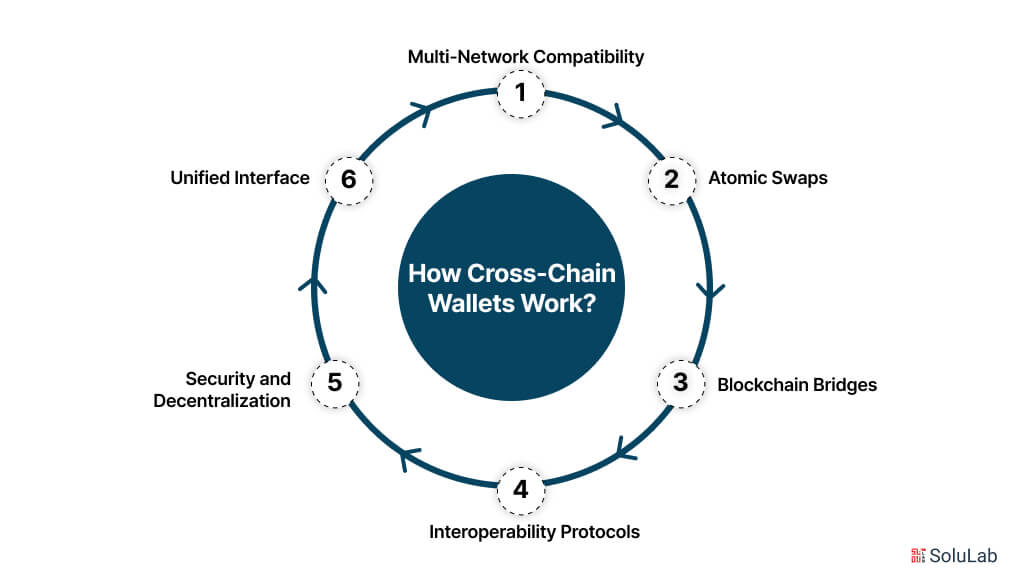
Cross-chain wallets are essential tools for managing assets across multiple blockchain networks in a seamless and secure manner. By using advanced technologies such as atomic swaps, blockchain bridges, and interoperability protocols, these wallets enable users to move assets between distinct blockchain ecosystems without the need for intermediaries or switching between wallets for different chains.
Key Components of Cross-Chain Wallets
- Multi-Network Compatibility: A core feature of cross-chain wallets is their ability to support multiple blockchains within a single interface. Users can access and manage assets across different chains, such as Ethereum, Binance Smart Chain, and Solana, from one wallet, thanks to the integration of a cross-chain network that connects various blockchain protocols.
- Atomic Swaps: Cross-chain wallets often implement atomic swaps, which allow users to exchange cryptocurrencies directly between two different blockchains without needing centralized exchanges. Atomic swaps use smart contracts to lock and release funds only when both parties meet the conditions, ensuring trustless and decentralized transactions between blockchains.
- Blockchain Bridges: Cross-chain bridges are another critical component of these wallets. They facilitate the movement of tokens and assets between separate blockchains. The process involves locking assets on the originating chain and minting equivalent tokens on the destination chain, allowing users to transfer value between ecosystems seamlessly.
- Interoperability Protocols: Cross-chain wallets rely on interoperability protocols to connect and interact with different blockchains. These protocols serve as the backbone for communication between distinct networks, enabling the wallet to facilitate transactions, data sharing, and smart contract execution across multiple blockchains without compatibility issues.
- Security and Decentralization: To ensure the safety of funds and data, cross-chain wallets typically employ decentralized security measures, such as cryptographic algorithms and smart contracts. These features help safeguard user assets while reducing reliance on central authorities, keeping transactions within the cross-chain network transparent and secure.
- Unified Interface: Users benefit from a unified interface that consolidates all their blockchain assets and interactions into one platform. This makes it easy to switch between blockchains, send and receive tokens, and track balances without having to use multiple wallets.
Examples of Successful Cross-Chain Projects
As the demand for blockchain interoperability grows, several projects have emerged that effectively implement cross-chain networks to connect distinct blockchain ecosystems. These projects use blockchain bridges and cross-chain integration to allow seamless asset transfers and communication between otherwise isolated blockchains. Below are some notable examples of successful cross-chain projects:
- Polkadot: One of the most prominent projects in the cross-chain space, Polkadot is a decentralized platform designed to enable different blockchains to transfer messages and value in a trustless manner. Through its cross-chain network, Polkadot connects multiple blockchains, ensuring blockchain interoperability. Its unique parachain architecture allows independent blockchains to communicate with each other, share data, and transfer assets, making it one of the leading solutions for cross-chain integration.
- Cosmos (ATOM): Often referred to as the “Internet of Blockchains,” Cosmos focuses on creating a network of blockchains that can interact with each other. It uses the Inter-Blockchain Communication (IBC) protocol to enable communication between chains, allowing for the transfer of tokens and data across various blockchains. This enhances interoperability and brings different ecosystems closer together through a robust cross-chain network.
- Wanchain: Wanchain is a project that focuses on building blockchain bridges to facilitate secure, decentralized asset transfers between different blockchains. It enables cross-chain smart contracts and decentralized financial applications, providing a comprehensive solution for cross-chain integration. Wanchain’s infrastructure bridges multiple chains, including Bitcoin, Ethereum, and Binance Smart Chain, driving cross-blockchain asset movement.
- Thorchain: Thorchain is a decentralized liquidity protocol that allows the transfer of assets across various blockchains in a cross-chain network. It is designed to enable the swap of cryptocurrencies without relying on centralized exchanges or custodians. Thorchain uses its native token, RUNE, to facilitate transactions across multiple chains, thereby supporting decentralized finance (DeFi) through cross-chain integration.
- Avalanche: Known for its high throughput and low latency, Avalanche has developed blockchain bridges to connect with Ethereum and other blockchains. This allows users to move assets between Avalanche and Ethereum, enhancing the ecosystem’s interoperability and usability. Avalanche’s cross-chain functionality is a key component in its strategy to create a more connected blockchain world.
Impact of Cross-Chain Compatibility on the Future of Cryptocurrency Exchanges
Cross-chain compatibility is transforming the future of cryptocurrency exchanges by enabling seamless interaction between different blockchain networks. As the demand for more flexible and interoperable blockchain ecosystems grows, the need for cross-chain networks becomes crucial. Traditional cryptocurrency exchanges are often limited by the constraints of operating within single-chain ecosystems, which leads to inefficiencies in trading across multiple blockchains. However, the development of cross-chain compatibility allows these platforms to overcome such limitations.
An interoperable blockchain infrastructure facilitates direct asset transfers between different blockchain networks without requiring intermediaries or centralized exchanges. This enhances liquidity across exchanges and minimizes the time and costs associated with moving digital assets. For instance, with cross-chain compatibility, users can trade Bitcoin on Ethereum-based exchanges or swap tokens across various blockchains in a frictionless manner. This not only improves the user experience but also opens up new opportunities for decentralized finance (DeFi) platforms and decentralized exchanges (DEXs).
Blockchain development companies are now at the forefront of building these cross-chain solutions, offering technologies that enhance network interoperability and bridge gaps between isolated ecosystems. These solutions will be critical in shaping the future of cryptocurrency exchanges by making them more scalable, user-friendly, and accessible across a variety of blockchain protocols.
Furthermore, cross-chain networks enable developers to innovate with multi-chain applications, creating decentralized ecosystems where users can easily switch between blockchain platforms. The development of interoperable blockchains and cross-chain networks is set to significantly change cryptocurrency exchanges. By allowing different blockchains to work together smoothly, users will be able to move assets between platforms without the current hassles or limitations. This increased connectivity will boost liquidity, meaning there will be more fluid trading and access to funds across exchanges. It will also help streamline trading by reducing delays and inefficiencies that come from operating within a single blockchain ecosystem.
In simple terms, cross-chain networks open the door to new innovations, especially in decentralized finance (DeFi) and other blockchain applications. Developers will be able to build more powerful and versatile platforms, where users can seamlessly interact across various blockchain networks. As a result, the future of cryptocurrency exchanges will be more interconnected, efficient, and ready to support the next generation of blockchain technology.
Use Cases of Cross-Chain Compatibility
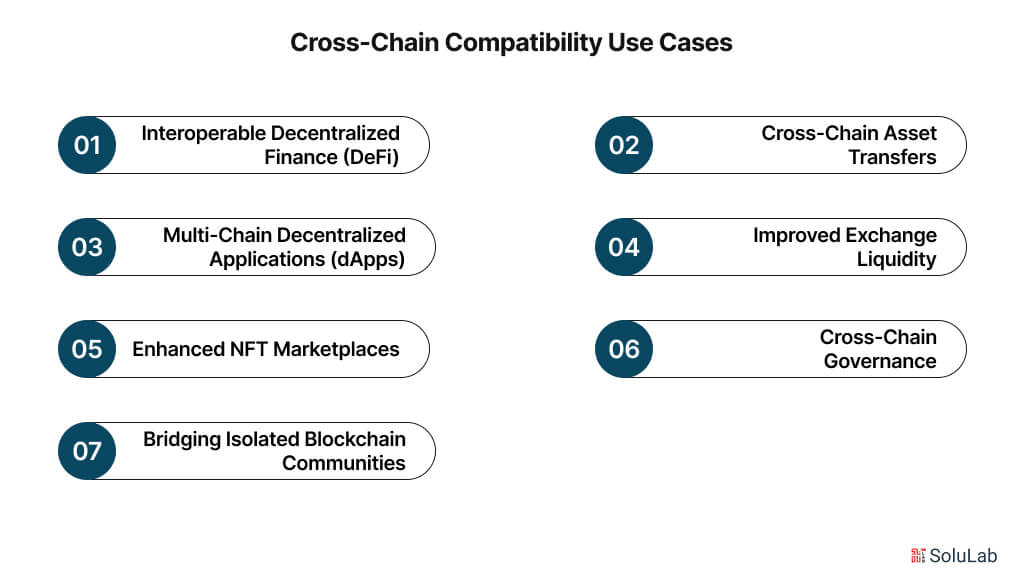
Cross-chain compatibility unlocks a wide range of use cases, enhancing the functionality and reach of blockchain ecosystems. Here are some key cross-chain blockchain use cases:
1. Interoperable Decentralized Finance (DeFi): One of the most promising use cases is in the DeFi sector. Cross-chain networks enable users to access a variety of DeFi protocols across multiple blockchains. For example, a user can lend assets on Ethereum, borrow on Binance Smart Chain, and swap tokens on Avalanche—all without leaving a single platform. This broadens the range of opportunities for earning, trading, and investing while enhancing liquidity across platforms.
2. Cross-Chain Asset Transfers: Traditionally, transferring assets like Bitcoin to an Ethereum-based exchange required a complex process involving wrapped tokens or intermediaries. With cross-chain compatibility, users can now move assets directly between blockchains. This makes the process faster, more secure, and less costly, enabling smoother transactions across different ecosystems.
3. Multi-Chain Decentralized Applications (dApps): Developers can create decentralized applications that run on multiple blockchains simultaneously, allowing users to access these apps from any blockchain network. For instance, a gaming dApp might allow players to earn rewards on one blockchain and spend them on another, providing a more fluid and accessible experience for users.
4. Improved Exchange Liquidity: Cross-chain networks allow decentralized exchanges (DEXs) to connect liquidity pools across multiple blockchains. This means that traders can access larger pools of capital, improving liquidity and reducing price slippage. Cross-chain compatibility is particularly beneficial for decentralized exchanges looking to compete with centralized counterparts by offering better prices and deeper markets.
5. Enhanced NFT Marketplaces: Cross-chain compatibility enables the trading of non-fungible tokens (NFTs) across different blockchain platforms. Users can buy, sell, and trade NFTs on multiple chains, unlocking a global market for digital assets. This interoperability could also make it easier to move NFTs between different blockchains, preserving ownership and value as users switch ecosystems.
6. Cross-Chain Governance: Decentralized autonomous organizations (DAOs) and other blockchain governance structures can benefit from cross-chain compatibility by allowing token holders to participate in governance activities across multiple blockchains. This enables a more inclusive and diverse decision-making process, ensuring that stakeholders from various ecosystems can have a say in project governance.
7. Bridging Isolated Blockchain Communities: Many blockchain networks operate in isolation, but cross-chain technology helps bridge these isolated communities. By allowing different blockchains to interact, projects can collaborate, share resources, and tap into a broader user base. This fosters greater innovation and adoption across the blockchain industry.
Cross-Chain Interoperability Protocols
Cross-chain interoperability protocols have become essential in the blockchain space, allowing various blockchain networks to communicate and operate seamlessly with one another. These protocols are key in promoting collaboration, expanding potential use cases, and improving the overall efficiency of decentralized applications.
-
Layerzero
Layerzero is an advanced cross-chain interoperability protocol that facilitates smooth asset transfers and data sharing between different blockchain platforms. Utilizing technologies such as sidechains, Layerzero enables fast and secure transactions across chains, boosting scalability and ease of use for decentralized applications. Its decentralized governance model encourages network participants to actively contribute to the growth of the cross-chain integration ecosystem.
-
Wormhole
Wormhole, developed by the Solana team, is a powerful cross-chain protocol that supports the transfer of assets and data across various blockchain networks, such as Ethereum and Solana. Through its token bridge mechanism, Wormhole enables secure and efficient blockchain bridges, unlocking new opportunities for developers and users. Wormhole also enhances its functionality by supporting decentralized autonomous organizations (DAOs) and smart contracts, increasing its value within the multi-chain compatibility environment.
-
Chainlink
Chainlink is a decentralized oracle network that plays a crucial role in cross-chain communication by delivering reliable and secure data feeds to smart contracts across different blockchain ecosystems. With Chainlink’s Oracle solutions, developers gain access to real-world data on-chain, enabling the execution of intricate cross-chain transactions. Chainlink’s widespread network of oracles and focus on data privacy make it a trusted option for projects requiring smooth cross-chain interactions.
-
Quant
Quant is a leading cross-chain interoperability protocol that seeks to connect various blockchain networks through its Overledger technology. Acting as a universal gateway, Quant facilitates seamless communication and asset transfers between blockchains, encouraging cross-chain collaboration and interoperability. Quant’s focus on security, scalability, and regulatory compliance places it at the forefront of cross-chain integration.
-
Flare
Flare is a decentralized network designed to enable trustless asset transfers and smart contract execution across multiple blockchains. Using its unique network architecture, Flare allows users to securely exchange assets and carry out complex cross-chain transactions. Its integration with Ethereum Virtual Machine (EVM) compatibility broadens the scope for developers interested in building cross-chain decentralized applications (dApps).
-
THORChain
THORChain is an innovative cross-chain interoperability protocol that uses cutting-edge cryptographic techniques to enable secure and efficient asset exchanges between blockchain networks. THORChain’s focus on scalability and privacy ensures users can move assets between chains without compromising on security or performance. Its decentralized governance and commitment to open standards make it a strong solution for seamless multi-chain compatibility.
-
Zetachain
Zetachain is a next-generation cross-chain protocol that aims to bridge the gap between different blockchain ecosystems using a decentralized infrastructure. Zetachain offers secure and efficient asset transfers and data exchange, fostering smooth communication and collaboration across blockchain bridges. Its strong focus on user privacy, decentralization, and scalability establishes Zetachain as a key player in the cross-chain integration space.
Future Trends and Developments in Cross-Chain Compatibility
As we look toward the future, cross-chain compatibility is set to play a crucial role in shaping the evolution of blockchain technology and cryptocurrency exchanges. Here are some key trends and advancements to keep an eye on.
- Cross-Chain Bridges and Global Transactions: The rise of cross-chain bridges is making international transactions faster and more efficient. These bridges enable seamless asset transfers across different blockchain networks, eliminating the need for intermediaries and reducing transaction fees. This development is expected to revolutionize global trade and financial transfers, making them more streamlined and cost-effective.
- Cross-Chain Decentralized Finance (DeFi): Cross-chain compatibility is about to bring major changes to the DeFi space. By allowing liquidity and assets to move freely across multiple blockchains, DeFi platforms will be able to offer a wider array of services, drawing in a more diverse user base. This enhanced interoperability is expected to fuel further innovation, making financial services more accessible and adaptable to users’ needs.
- Scalability and Cross-Chain Solutions: Scalability has long been a significant challenge in blockchain technology, but cross-chain solutions are emerging as a potential solution. By linking different blockchain networks and allowing them to share resources, these solutions can boost transaction speeds and increase overall network capacity. As more projects embrace cross-chain technology, the scalability issues currently hindering blockchain development could become a thing of the past, paving the way for a new generation of blockchain-based applications and services.
How SoluLab is Leading the Way in Blockchain and Cross-Chain Solutions?
SoluLab is a leader in blockchain development, helping businesses tap into the potential of cross-chain technology to streamline operations and enable seamless asset transfers between different blockchain networks. By developing innovative solutions like blockchain bridges and ensuring multi-chain compatibility, SoluLab- as a blockchain development company, makes it easier for companies to adopt decentralized finance (DeFi), NFTs, and smart contracts. This means better scalability, improved efficiency, and stronger security for your business.
At SoluLab, we recently launched a project on Morpheus.Network, a blockchain-powered SaaS solution designed to simplify and secure logistics. By integrating blockchain, IoT, and SMS notifications, Morpheus.Network bridges the gap between legacy and emerging technologies, empowering logistics businesses with real-time visibility, enhanced efficiency, and optimized supply chain management. This innovative platform is driving the future of decentralized logistics solutions.
We tailor our solutions to meet the unique needs of each client, whether you’re a startup or an established enterprise. From building custom cross-chain protocols to optimizing your current blockchain infrastructure, we’ve got you covered. Ready to future-proof your business with the latest blockchain solutions? Contact us today and let’s get started!
FAQs
1. What is cross-chain compatibility, and why is it important for blockchain?
Cross-chain compatibility allows different blockchain networks to communicate and transfer assets seamlessly. This is important because it eliminates the need for intermediaries, reduces transaction costs, and enables greater liquidity across platforms. It also opens up more opportunities for decentralized finance (DeFi) and other blockchain applications.
2. How can cross-chain technology benefit my business?
Cross-chain technology can enhance the scalability and flexibility of your operations by allowing your business to interact with multiple blockchain networks. This means you can access new markets, leverage decentralized finance (DeFi) platforms, and use digital assets from different ecosystems without the need for complex conversions or third-party services. It’s a way to future-proof your business in the rapidly evolving blockchain space.
3. What is the difference between cross-chain compatibility and traditional blockchain networks?
Traditional blockchain networks operate in isolation, meaning they cannot directly communicate or transfer assets with other blockchains. Cross-chain compatibility, on the other hand, allows different blockchain networks to interact, enabling the seamless transfer of assets and data between them. This leads to improved scalability, efficiency, and the creation of a more interconnected blockchain ecosystem.
4. How does cross-chain compatibility enhance decentralized finance (DeFi)?
Cross-chain compatibility boosts DeFi by allowing liquidity and assets to flow freely across different blockchain networks. This increases access to a broader range of financial products and services, enabling users to engage with various DeFi platforms without being confined to a single blockchain. It also helps in improving liquidity, reducing fees, and expanding opportunities for innovation in decentralized financial systems.
5. What kind of cross-chain solutions does SoluLab provide?
SoluLab offers a range of cross-chain solutions, including blockchain bridges for seamless asset transfers, multi-chain decentralized applications (dApps), and smart contract development that operates across various blockchain networks. Our solutions are designed to enhance scalability, improve efficiency, and ensure the security of your operations, all tailored to your business needs.
6. How can SoluLab help my business implement cross-chain technology?
SoluLab specializes in integrating cross-chain technology with your existing blockchain infrastructure. We can help your business connect with multiple blockchain networks, enabling smoother asset transfers, improving scalability, and giving you access to decentralized finance (DeFi) platforms and other blockchain innovations. Reach out to us for custom solutions that align with your goals.





